![]()
![]()
![]()
Use LEFT and RIGHT arrow keys to navigate between flashcards;
Use UP and DOWN arrow keys to flip the card;
H to show hint;
A reads text to speech;
201 Cards in this Set
- Front
- Back

|
Didelphis virginiana (opossum)
*only didelphidae: small bullae; polyprotodont; 5/4 incisors skin: gray/white-brown pelage; pouch; scaly tail skull: 5/4 Incisors; sagittal crest, upside-down heart shaped first b premolar |
|

|
Didelphis virginiana (opossum)
*only didelphidae: small bullae; polyprotodont; 5/4 incisors skin: gray/white-brown pelage; pouch; scaly tail skull: 5/4 Incisors; sagittal crest, upside-down heart shaped first b premolar |
|
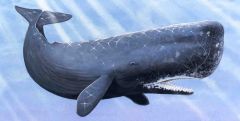
|
Physeter catodon (sperm whale)
skin: large, square head |
|

|
Balaenoptera sp. (blue, sei, fin, minke whale)
skin: many furrows; short, thick baleen |
|

|
Phocoena phocoena (harbor porpoise)
skin: dolphin without chin/beak |
|

|
Orcinus orca (killer whale)
skin: really? |
|

|
Eschrichtius robustus (gray whale)
skin: few furrows; no dorsal fin; spotty gray and white usually covered with barnacles |
|

|
Eubalaena glacialis (northern right whale)
skin: huge baleen; no dorsal fin; arched mouth, large and black, usually with white spots and/or barnacles |
|

|
Scapanus (some moles)
*thin, complete zygomatic arch; super flat skull skull: 11 lower teeth; thin, complete zygomatic arch; very flat |
|
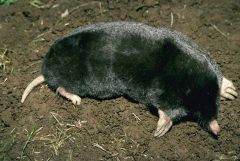
|
Scapanus townsendii (Townsend's mole)
*thin, complete zygomatic arch; super flat skull skin: 'hands;' larger; dark brown/black fur; nearly-naked tail |
|

|
Scapanus latimanus (broad-footed mole)
*thin, complete zygomatic arch; super flat skull skin: medium; coffee colored fur; furred tail |
|

|
Neurotrichus gibbsii (American shrew-mole)
*thin, complete zygomatic arch; super flat skull skin: smallest; longish tail; shrew face; uniform dark fur skull: tiny; 8-9 lower teeth |
|

|
Neurotrichus gibbsii (American shrew-mole)
*thin, complete zygomatic arch; super flat skull skin: smallest; longish tail; shrew face; uniform dark fur skull: tiny; 8-9 lower teeth |
|
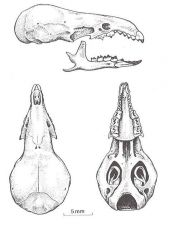
|
Sorex (some shrews)
*1st incisor accessory cusp; base-rounded arrow shape; no zygomatic arch skull: 5 upper unicuspid teeth |
|

|
Notiosorex crawfordi (desert shrew)
*1st incisor accessory cusp; base-rounded arrow shape; no zygomatic arch skin: small; unicolored tail; gray color; brown feet skull: 3 upper unicuspid teeth |
|

|
Notiosorex crawfordi (desert shrew)
*1st incisor accessory cusp; base-rounded arrow shape; no zygomatic arch skin: small; unicolored tail; gray color; brown feet skull: 3 upper unicuspid teeth |
|

|
Sorex palustris (water shrew)
skin: larger; dark color; feet with stiff white hair fringe |
|

|
Sorex sonomae (fog shrew)
skin: red color |
|

|
Sorex vagrans (vagrant shrew)
skin: smaller; dark color; bicolored tail; orange feet |
|

|
Eumops perotis (western mastiff bat)
*free tail; 1 pair upper incisors skin: ears joined at tips skull: 1 pair upper incisor; joined premaxilla |
|

|
Eumops perotis (western mastiff bat)
*free tail; 1 pair upper incisors skin: ears joined at tips skull: 1 pair upper incisor; joined premaxilla |
|

|
Tadarida brasiliensis (Brazilian free-tail bat)
*free tail; 1 pair upper incisors skin: chocolate color; free tail skull: 1 pair upper incisors; 5 upper cheekteeth; longer rostrum |
|
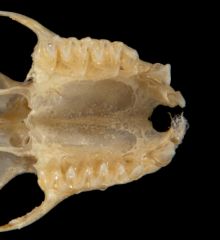
|
Tadarida brasiliensis (Brazilian free-tail bat)
*free tail; 1 pair upper incisors skin: chocolate color; free tail skull: 1 upper incisors; 5 upper cheekteeth; longer rostrum |
|

|
Macrotus californicus (California leaf-nosed bat)
*only phyllostomidae: 2 upper incisors; premaxilla not split; small tragus skin: light fur; short tail skull: joined premaxilla; 2 upper incisors |
|

|
Macrotus californicus (California leaf-nosed bat)
*only phyllostomidae: 2 upper incisors; premaxilla not split; small tragus skin: light fur; short, free tail skull: joined premaxilla; 2 upper incisors |
|

|
Antrozous pallidus (Pallid bat)
*split premaxilla; large tragus; long, enclosed tail skin: buff color; long, enclosed tail skull: 1 pair upper incisors; ridges on snout |
|

|
Antrozous pallidus (Pallid bat)
*split premaxilla; large tragus; long, enclosed tail skin: buff color; long ears skull: 1 pair upper incisors; ridges on snout |
|

|
Corynorhinus townsendii (Townsend's long-eared bat)
*split premaxilla; large tragus; long, enclosed tail skin: joined ears skull: 2 upper incisors; 5/6 cheekteeth; no nasal depression |
|

|
Corynorhinus townsendii (Townsend's long-eared bat)
*split premaxilla; large tragus; long, enclosed tail skin: joined ears skull: 2 upper incisors; 5/6 cheekteeth; no nasal depression |
|

|
Eptesicus fuscus (big brown bat)
*split premaxilla; large tragus; long, enclosed tail skin: brown fur, black membrane; dog face skull: 2 upper incisors; 4 upper cheekteeth |
|

|
Eptesicus fuscus (big brown bat)
*split premaxilla; large tragus; long, enclosed tail skin: brown fur, black membrane; dog face skull: 2 upper incisors; 4 upper cheekteeth |
|

|
Lasionycteris noctivagans (silver-haired bat)
*split premaxilla; large tragus; long, enclosed tail skin: dark brown color; white-tipped fur skull: 2 upper incisors; 5/6 cheekteeth; nare depression |
|

|
Lasionycteris noctivagans (silver-haired bat)
*split premaxilla; large tragus; long, enclosed tail skin: dark brown color; white-tipped fur skull: 2 upper incisors; 5/6 cheekteeth; nare depression |
|

|
Lasiurus
*split premaxilla; large tragus; long, enclosed tail skull: wider>longer rostrum; 1 upper incisor |
|
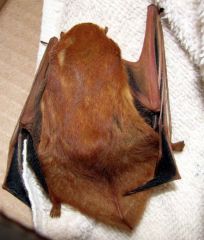
|
Lasiurus blossevillii (western red bat)
*split premaxilla; large tragus; long, enclosed tail skin: red fur |
|
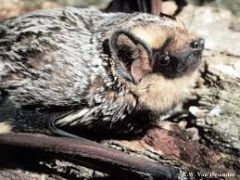
|
Lasiurus cinereus (hoary bat)
*split premaxilla; large tragus; long, enclosed tail skin: brown fur with frosty-white tips |
|
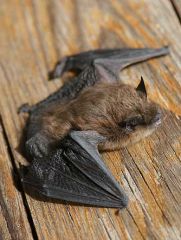
|
Myotis sp.
*split premaxilla; large tragus; long, enclosed tail skin: small; dark color skull: 2 upper incisors; 6 upper cheekteeth |
|
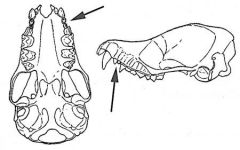
|
Myotis sp.
*split premaxilla; large tragus; long, enclosed tail skin: small; dark color skull: 2 upper incisors; 6 upper cheekteeth |
|
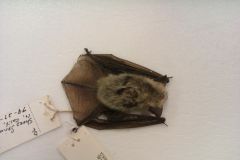
|
Parastrellus hesperus (western pipistrelle)
*split premaxilla; large tragus; long, enclosed tail skin: light/gray fur, dark brown membrane; small skull: 2 upper incisors; 5/5 cheekteeth (1 tiny upper) --> my favorite bat :D <-- |
|
|
*Need picture: smallest skull
|
Parastrellus hesperus (western pipistrelle)
*split premaxilla; large tragus; long, enclosed tail skin: light/gray fur, dark brown membrane; small skull: smallest skull; 2 upper incisors; 5/5 cheekteeth; nare depression --> my favorite bat :D <-- |
|

|
Euderma maculatum (spotted bat)
*split premaxilla; large tragus; long, enclosed tail skin: spotted fur skull: |
|
|
*skull:
|
Euderma maculatum (spotted bat)
*split premaxilla; large tragus; long, enclosed tail skin: spotted fur skull: 2 upper incisors; 5/5 cheekteeth; no nasal depression |
|

|
Canis latrans (coyote)
*long, narrow rostrum; alisphenoid canal present; last molar long inwardly skin: think you got this. skull: biggest dog skull, ‘Y’ temporal ridge. |
|
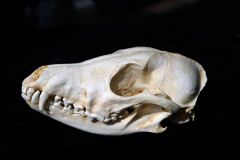
|
Canis latrans (coyote)
*long, narrow rostrum; alisphenoid canal present; last molar long inwardly skin: think you got this. skull: biggest dog skull, ‘Y’ temporal ridge. |
|

|
Urocyon cinereoargenteus (common gray fox)
*long, narrow rostrum; alisphenoid canal present; last molar long inwardly skin: gray fox skull: lyre-shaped temporal ridge |
|

|
Urocyon cinereoargenteus (common gray fox)
*long, narrow rostrum; alisphenoid canal present; last molar long inwardly skin: gray fox skull: lyre-shaped temporal ridge |
|

|
Vulpes macrotis (kit fox)
*long, narrow rostrum; alisphenoid canal present; last molar long inwardly skin: buff colored fox skull: no temporal ridge |
|

|
Vulpes macrotis (kit fox)
*long, narrow rostrum; alisphenoid canal present; last molar long inwardly skin: buff colored fox skull: no temporal ridge |
|

|
Vulpes vulpes (red fox)
*long, narrow rostrum; alisphenoid canal present; last molar long inwardly skin: red fox skull: ‘v’ shaped temporal ridge |
|

|
Vulpes vulpes (red fox)
*long, narrow rostrum; alisphenoid canal present; last molar long inwardly skin: red fox skull: ‘v’ shaped temporal ridge |
|

|
Puma concolor (puma)
*looks like a primate skull with carnivore teeth skin: it’s the big freakin’ cat skull: larger; 3 upper premolars |
|

|
Puma concolor (puma)
*looks like a primate skull with carnivore teeth skin: it’s the big freakin’ cat skull: larger; 3 upper premolars |
|

|
Lynx rufus (bobcat)
*looks like a primate skull with carnivore teeth skin: The smaller one skull: smaller; 2 upper premolars |
|

|
Lynx rufus (bobcat)
*looks like a primate skull with carnivore teeth skin: The smaller one skull: smaller; 2 upper premolars |
|

|
Enhydra lutris (sea otter)
*lock jaw; carnivore skin: larger; thick, unicolor fur skull: complete lock jaw; stout skull |
|
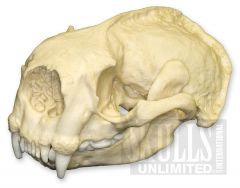
|
Enhydra lutris (sea otter)
*lock jaw; carnivore skin: larger; thick, unicolor fur skull: complete lock jaw; stout skull |
|

|
Gulo gulo (wolverine)
*lock jaw; carnivore skin: not part of the x-men skull: complete lock jaw; not rounded |
|

|
Gulo gulo (wolverine)
*lock jaw; carnivore skin: not part of the x-men skull: complete lock jaw; not rounded |
|

|
Lontra canadensis (northern river otter)
*lock jaw; carnivore skin: smaller; light chin skull: smooth; flattened |
|
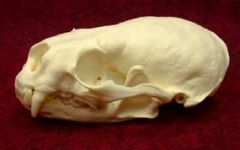
|
Lontra canadensis (northern river otter)
*lock jaw; carnivore skin: smaller; light chin skull: smooth; flattened |
|

|
Martes caurina (Pacific marten)
*lock jaw; carnivore skin: light brown color; black paws; fluffy tail |
|
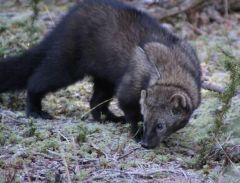
|
Pekania pennanti (Fisher)
*lock jaw; carnivore skin: largest ‘weasel;’ dark color |
|

|
Mustela (some weasels)
*lock jaw; carnivore skull: long auditory bullae; derpy-dumbell upper molar |
|

|
Mustela erminea (Ermine, short-tailed weasel)
*lock jaw; carnivore skin: weasel without mask; white belly or completely white |
|

|
Mustela erminea (Ermine, short-tailed weasel)
*lock jaw; carnivore skin: no mask; short tail; white belly (winter: white with black tip) |
|

|
Mustela frenata (long-tailed weasel)
*lock jaw; carnivore skin: orange/yellow belly; face 'mask;' long tail (winter: white with black tip) |
|

|
Mustela frenata (long-tailed weasel)
*lock jaw; carnivore skin: orange/yellow belly; face 'mask;' long tail (winter: white with black tip) |
|

|
Neovison vison (mink)
*lock jaw; carnivore skin: dark unicolor; skinny tail skull: sagittal crest and mastoid process prominent |
|

|
Neovison vison (mink)
*lock jaw; carnivore skin: dark unicolor; skinny tail skull: sagittal crest and mastoid process prominent |
|
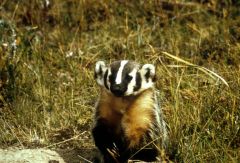
|
Taxidea taxus (American badger)
*lock jaw; carnivore skin: Taxidea taxus takes what it wants skull: long palate, triangular skull |
|

|
Taxidea taxus (American badger)
*lock jaw; carnivore skin: Taxidea taxus takes what it wants skull: long palate, triangular skull |
|

|
Mephitis mephitis (striped skunk)
*last upper molar is very square skin: striped skull: larger; mastoid process extends outwards |
|

|
Mephitis mephitis (striped skunk)
*last upper molar is very square skin: striped skull: larger; mastoid process extends outwards |
|

|
Spilogale gracilis (western spotted skunk)
*last upper molar is very square skin: banded/spotted skull: smaller; almost no mastoid process |
|

|
Spilogale gracilis (western spotted skunk)
*last upper molar is very square skin: banded/spotted skull: smaller; almost no mastoid process |
|

|
Bassariscus astutus (ringtail [raccoon])
*weak carnassials, 6 cheekteeth skin: smaller; buff color skull: palate stops at last tooth |
|
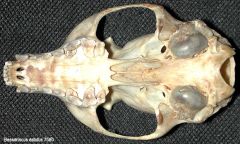
|
Bassariscus astutus (ringtail [raccoon])
*weak carnassials, 6 cheekteeth skin: smaller; buff color skull: palate stops at last tooth |
|

|
Procyon lotor (northern raccoon)
*weak carnassials, 6 cheekteeth skin: ‘typical’ raccoon skull: palate extends past teeth |
|

|
Procyon lotor (northern raccoon)
*weak carnassials, 6 cheekteeth skin: ‘typical’ raccoon skull: palate extends past teeth |
|

|
Ursus americanus (American black bear)
*only ursidae: weak carnassials, bunodont teeth |
|

|
Ursus americanus (American black bear)
*only ursidae: weak carnassials, bunodont teeth |
|
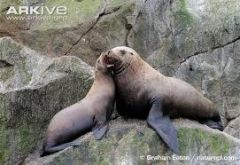
|
Eumetopias jubatus (Steller’s sea lion)
*singled-cusped ‘peg’ teeth; external ears skin: external ears; fuzzy; predominantly brown |
|

|
Zalophus californianus (California sea lion)
*singled-cusped ‘peg’ teeth; external ears skin: external ears; smooth skin; predominantly black |
|

|
Mirounga angustirostris (northern elephant seal)
*double-cusped ‘peg’ teeth skin: males have fat nose (proboscis); females have flattened snout |
|

|
Mirounga angustirostris (northern elephant seal)
*double-cusped ‘peg’ teeth skin: males have fat nose (proboscis); females have flattened snout |
|

|
Phoca vitulina (harbor seal)
*double-cusped ‘peg’ teeth skin: spotted |
|

|
Ochotona princeps (pika)
*only ochotonidae: Tiny 2nd pair of incisors behind first; ‘^’ shaped bottom of front teeth; no supraorbital process skin/skull: it’s a pika… |
|

|
Ochotona princeps (pika)
*only ochotonidae: Tiny 2nd pair of incisors behind first; ‘^’ shaped bottom of front teeth; no supraorbital process skin/skull: it’s a pika… |
|

|
Lepus (hares)
*Tiny 2nd pair of incisors behind first; flat bottom of front teeth; supraorbital process skull: rectangular supraoccipital shield; huge orbits |
|

|
Lepus americanus (snowshoe hare)
*Tiny 2nd pair of incisors behind first; flat bottom of front teeth; supraorbital process skin: short ears; white or brown fur; tiny tail |
|
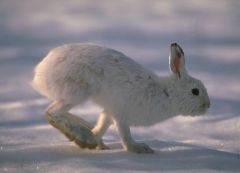
|
Lepus americanus (snowshoe hare)
*Tiny 2nd pair of incisors behind first; flat bottom of front teeth; supraorbital process skin: short ears; white or brown fur; tiny tail |
|

|
Lepus californicus (black-tailed jackrabbit)
*Tiny 2nd pair of incisors behind first; flat bottom of front teeth; supraorbital process skin: long ears; tail black on top, gray on bottom; tiny tail |
|
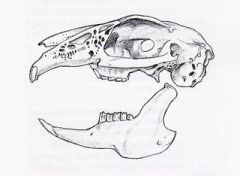
|
Sylvilagus (bunnies)
*Tiny 2nd pair of incisors behind first; flat bottom of front teeth; supraorbital process skull: supraoccipital square |
|

|
Sylvilagus audubonii (Audubon’s cottontail)
*Tiny 2nd pair of incisors behind first; flat bottom of front teeth; supraorbital process skin: smaller ears/feet; bare ears; furry (not wooly); prominent tail |
|

|
Sylvilagus bachmani (brush rabbit)
*Tiny 2nd pair of incisors behind first; flat bottom of front teeth; supraorbital process skin: smallest; white feet; dark body; bare ears |
|

|
Sylvilagus nuttallii (mountain cottontail)
*Tiny 2nd pair of incisors behind first; flat bottom of front teeth; supraorbital process skin: large, poofy tail; furry ears; grayer |
|
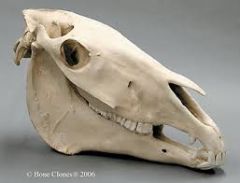
|
Equus (horse-ish)
*only equidae: long rostrum; awkward large mandible; prominent nasals skull: equidae skull |
|

|
Equus asinus (burro)
*long rostrum; awkward large mandible; prominent nasals skin: donkey-horse |
|
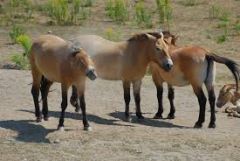
|
Equus caballus (feral horse)
*long rostrum; awkward large mandible; prominent nasals skin: horse… |
|

|
Antilocapra americana (pronghorns)
*only antilocapridae: pronghorns Skin/skull: pronghorns |
|
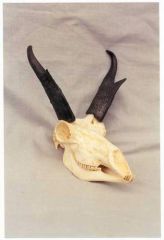
|
Antilocapra americana (pronghorns)
*only antilocapridae: pronghorns Skin/skull: pronghorns |
|
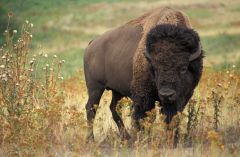
|
Bison bison (American bison)
*(usually) horns for both genders; 2 holes on brow angled sideways (from front view) skin: BIG FUZZY BISON skull: BIG |
|

|
Bison bison (American bison)
*(usually) horns for both genders; 2 holes on brow angled sideways (from front view) skin: BIG FUZZY BISON skull: BIG |
|

|
Ovis canadensis (bighorn sheep)
*(usually) horns for both genders; 2 holes on brow angled sideways (from front view) skin/skull: big brown sheep with curvy horns (bigger on males) |
|

|
Ovis canadensis (bighorn sheep)
*(usually) horns for both genders; 2 holes on brow angled sideways (from front view) skin/skull: big brown sheep with curvy horns (bigger on males) |
|

|
Ovis canadensis (bighorn sheep)
*(usually) horns for both genders; 2 holes on brow angled sideways (from front view) skin/skull: big brown sheep with curvy horns (bigger on males) |
|

|
Ovis canadensis (bighorn sheep)
*(usually) horns for both genders; 2 holes on brow angled sideways (from front view) skin/skull: big brown sheep with curvy horns (bigger on males) |
|
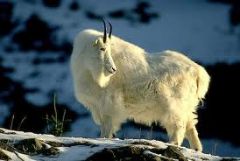
|
Oreamnos americanus (mountain goat)
*(usually) horns for both genders; 2 holes on brow angled sideways (from front view) skin: fuzzy white goat skull: black, slender horn sheaths |
|

|
Oreamnos americanus (mountain goat)
*(usually) horns for both genders; 2 holes on brow angled sideways (from front view) skin: fuzzy white goat skull: black, slender horn sheaths |
|

|
Cervus elaphus (elk)
*2 holes on brow angled straight down; antlers skin: red; males have large antlers; very furry/fuzzy neck skull: long nasals and antlers |
|

|
Cervus elaphus (elk)
*2 holes on brow angled straight down; antlers skin: red; males have large antlers; very furry/fuzzy neck skull: long nasals and antlers |
|
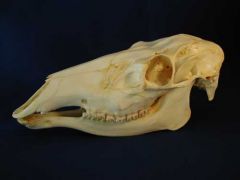
|
Cervus elaphus (elk)
*2 holes on brow angled straight down; antlers skin: red; males have large antlers; very furry/fuzzy neck skull: long nasals and antlers |
|

|
Cervus elaphus (elk)
*2 holes on brow angled straight down; antlers skin: red; males have large antlers; very furry/fuzzy neck skull: long nasals and antlers |
|

|
Sus scrofa (feral hog)
*only suidae: long paraoccipital process; ‘Y’ shaped occipital crest bump skin: it’s a pig skull: ‘Y’-shaped occipital crest bump |
|

|
Sus scrofa (feral hog)
*only suidae: long paraoccipital process; ‘Y’ shaped occipital crest bump skin: it’s a pig skull: ‘Y’-shaped occipital crest bump |
|

|
Odocoileus (black or white-tailed deer)
*2 holes on brow angled straight down; antlers skull: dichotomous branched antlers |
|

|
Odocoileus hemionus (black-tailed deer, mule deer)
*2 holes on brow angled straight down; antlers skin: grayish; short white to black tails skull (males only): dichotomous branched antlers |
|

|
Odocoileus hemionus (black-tailed deer, mule deer)
*2 holes on brow angled straight down; antlers skin: grayish; short white to black tails skull (males only): dichotomous branched antlers |
|
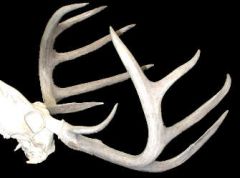
|
Odocoileus virginianus (white-tailed deer)
*2 holes on brow angled straight down; antlers skin: brownish; long, ventrally white tails skull (males only): only branched from main stem |
|

|
Odocoileus virginianus (white-tailed deer)
*2 holes on brow angled straight down; antlers skin: brownish; long, ventrally white tails skull (males only): only branched from main stem |
|
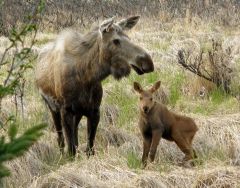
|
Alces alces (moose)
*2 holes on brow angled straight down; antlers skin: largest cervidae; wide antlers in males skull: largest cervidae; wide antlers in males; short nasals |
|
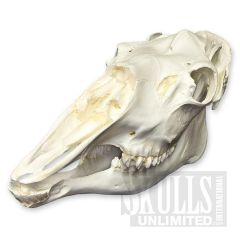
|
Alces alces (moose)
*2 holes on brow angled straight down; antlers skin: largest cervidae; wide antlers in males skull: largest cervidae; wide antlers in males; short nasals |
|

|
Alces alces (moose)
*2 holes on brow angled straight down; antlers skin: largest cervidae; wide antlers in males skull: largest cervidae; wide antlers in males; short nasals |
|

|
Rangifer tarandus (caribou)
*2 holes on brow angled straight down; antlers skin: huge dichotomous-branched antler (smaller in females); white neck tuft skull: shallow nasolacrimal gap; large dichotomously branching antlers (smaller in females) |
|

|
Rangifer tarandus (caribou)
*2 holes on brow angled straight down; antlers skin: huge dichotomous-branched antler (smaller in females); white neck tuft skull: shallow nasolacrimal gap; large dichotomously branching antlers (smaller in females) |
|

|
Rangifer tarandus (caribou)
*2 holes on brow angled straight down; antlers skin: huge dichotomous-branched antler (smaller in females); white neck tuft skull: shallow nasolacrimal gap; large dichotomously branching antlers (smaller in females) |
|

|
Aplodontia rufa (mountain beaver)
*only aplodontidae: apple-shaped teeth skin: dense, dark fur; stub tail skull: apple teeth |
|
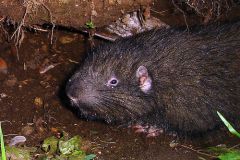
|
Aplodontia rufa (mountain beaver)
*only aplodontidae: apple-shaped teeth skin: dense, dark fur; stub tail skull: apple teeth |
|

|
Castor canadensis (American beaver)
*only castoridae: thumb-sized depression between auditory bullae (in basioccipital) skin: makes dams skull: thumb depression in basioccipital |
|

|
Castor canadensis (American beaver)
*only castoridae: thumb-sized depression between auditory bullae (in basioccipital) skin: makes dams skull: thumb depression in basioccipital |
|

|
Erethizon dorsatum (porcupine)
*only erethizontidae: flat, long braincase; bat-shaped teeth; spines that go to head; very little hair skin: spikey one skull: orange, bat-shaped teeth |
|

|
Erethizon dorsatum (porcupine)
*only erethizontidae: flat, long braincase; bat-shaped teeth; spines that go to head; very little hair skin: spikey one skull: orange, bat-shaped teeth |
|

|
Sigmodon hispidus (Hispid cotton rat)
*only sigmodontinae: ‘S’-shaped teeth skin: ‘fuzzy’ fur; naked, short tail skull: |
|

|
Sigmodon hispidus (Hispid cotton rat)
*only sigmodontinae: ‘S’-shaped teeth skin: ‘fuzzy’ fur; naked, short tail skull: |
|

|
Mus musculus (house mouse)
*’S’-shaped teeth skin: unicolored body; naked front feet; naked tail; small skull: tiny; notch in upper incisors |
|
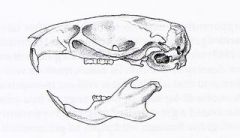
|
Mus musculus (house mouse)
*’S’-shaped teeth skin: unicolored body; naked front feet; naked tail; small skull: tiny; notch in upper incisors |
|

|
Rattus (rats)
*’S’-shaped teeth skull: large teeth; prominent temporal ridge |
|

|
Rattus norvegicus (Norway rat)
*’S’-shaped teeth skin: large rat; rough, dirty-brown fur; nearly naked tail |
|

|
Rattus rattus (black rat)
*’S’-shaped teeth skin: smaller rat; darker; naked tail |
|

|
Zapus (jumping mice)
*only dipodidae: large infraorbital foramen; no zygomatic plate; ‘8’ shape premolars skull: only dipodidae |
|

|
Zapus princeps (western jumping mouse)
*large infraorbital foramen; no zygomatic plate; ‘8’ shape premolars skin: red cheeks; bare-ish feet |
|

|
Zapus trinotatus (Pacific jumping mouse)
*large infraorbital foramen; no zygomatic plate; ‘8’ shape premolars skin: darker sides; furry feet |
|
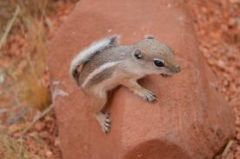
|
Ammospermophilus leucurus (antelope ground squirrel)
*slit-like infraorbital foramen; postorbital process/spine skin: small; white stripes on sides skull: orbits pinch in then fan out |
|
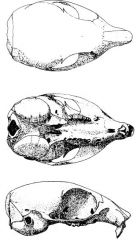
|
Ammospermophilus leucurus (antelope ground squirrel)
*slit-like infraorbital foramen; postorbital process/spine skin: small; white stripes on sides skull: orbits pinch in then fan out |
|

|
Glaucomys sabrinus (northern flying squirrel)
*slit-like infraorbital foramen; postorbital process/spine skin: squirrel with ‘wings’ skull: peg tooth looks fused to next cheek tooth; terragoid processes almost connect to bullae and make a shallow curve in shape |
|

|
Glaucomys sabrinus (northern flying squirrel)
*slit-like infraorbital foramen; postorbital process/spine skin: squirrel with ‘wings’ skull: peg tooth looks fused to next cheek tooth; terragoid processes almost connect to bullae and makes a shallow curve in shape |
|

|
Marmota flaviventris (marmot)
*slit-like infraorbital foramen; postorbital process/spine skin: fat; tail; yellow belly skull: like a beaver skull without the basioccipital thumb depression; no depression between orbits |
|

|
Marmota flaviventris (marmot)
*slit-like infraorbital foramen; postorbital process/spine skin: fat; tail; yellow belly skull: like a beaver skull without the basioccipital thumb depression; no depression between orbits |
|

|
Sciurus carolinensis (eastern gray squirrel) OR Sciurus griseus (western gray squirrel)
*slit-like infraorbital foramen; postorbital process/spine skull: 5 cheekteeth, first is a peg tooth |
|

|
Sciurus carolinensis (eastern gray squirrel)
*slit-like infraorbital foramen; postorbital process/spine skin: red and grey color (look at feet) |
|
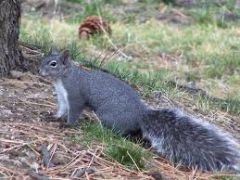
|
Sciurus griseus (western gray squirrel)
*slit-like infraorbital foramen; postorbital process/spine skin: gray color only (look at feet) |
|

|
Sciurus niger (fox squirrel)
*slit-like infraorbital foramen; postorbital process/spine skin: red color only (look at feet) skull: 4 cheekteeth, no peg |
|

|
Sciurus niger (fox squirrel)
*slit-like infraorbital foramen; postorbital process/spine skin: red color only (look at feet) skull: 4 cheekteeth, no peg |
|

|
Otospermophilus beecheyi (California ground squirrel)
*slit-like infraorbital foramen; postorbital process/spine skin: patchy white and dark brown fur |
|

|
Urocitellus beldingi (Belding’s ground squirrel)
*slit-like infraorbital foramen; postorbital process/spine skin: tail slightly longer than feet; dark brown back with light sides |
|

|
Callospermophilus lateralis (golden-mantled ground squirrel)
*slit-like infraorbital foramen; postorbital process/spine skin: like chipmunk without head stripes |
|

|
Tamias (chipmunks)
*slit-like infraorbital foramen; postorbital process/spine skull: tiny postorbital process; infraorbital foramen like holes |
|

|
Tamias amoenus (yellow-pine chipmunk)
*slit-like infraorbital foramen; postorbital process/spine skin: reddist chipmunk |
|
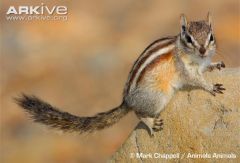
|
Tamias minimus (least chipmunk)
*slit-like infraorbital foramen; postorbital process/spine skin: smallest and lightest chipmunk |
|

|
Tamias senex (shadow chipmunk)
*slit-like infraorbital foramen; postorbital process/spine skin: largest and darkest chipmunk |
|

|
Tamiasciurus douglasii (Douglas’s squirrel)
*slit-like infraorbital foramen; postorbital process/spine skin: dark back with black stripe and buff belly skull: 3 internal septa visible in auditory bullae |
|

|
Tamiasciurus douglasii (Douglas’s squirrel)
*slit-like infraorbital foramen; postorbital process/spine skin: dark back with black stripe and buff belly skull: 3 internal septa visible in auditory bullae |
|
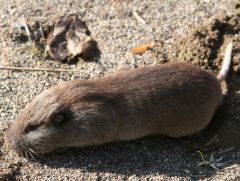
|
Thomomys (pocket gophers)
*only geomidae: deep post-palatal pits; ‘8’-shaped premolars skin: pocket gopher-y |
|
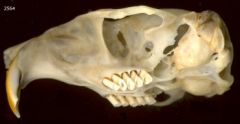
|
Thomomys bottae (Botta’s pocket gopher)
*deep post-palatal pits; ‘8’-shaped premolars skull: bigger; large crevice instead of a hole in inner orbital (sphenoidal fissure); huge side mandibular processes |
|
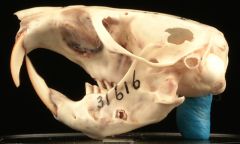
|
Thomomys talpoides (northern pocket gopher)
*deep post-palatal pits; ‘8’-shaped premolars skull: smaller; no sphernoidal fissure (just a hole in inner orbital) |
|

|
Dipodomys (large kangaroo rats)
*hole through rostrum; nasals extend past incisors skull: enlarge auditory bullae; rostral portion of zygomatic arch flat/plate |
|

|
Dipodomys californicus (California kangaroo rat)
*hole through rostrum; nasals extend past incisors skin: dark; ‘skunk’ tail coloring |
|

|
Dipodomys deserti (desert kangaroo rat)
*hole through rostrum; nasals extend past incisors skin: largest; buff color; white tail |
|

|
Dipodomys merriami (Merriam’s kangaroo rat)
*hole through rostrum; nasals extend past incisors skin: buff color; brown tail |
|
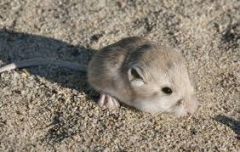
|
Microdipodops megacephalus (dark kangaroo rat)
*hole through rostrum; nasals extend past incisors skin: smallest; very soft skull: smallest; large auditory bullae |
|

|
Microdipodops megacephalus (dark kangaroo rat)
*hole through rostrum; nasals extend past incisors skin: smallest; very soft skull: smallest; large auditory bullae |
|

|
Chaetodipus (some pocket mice)
*hole through rostrum; nasals extend past incisors skull: interparietal width > foramen magnum width Perognathus (some pocket mice) *hole through rostrum; nasals extend past incisors skull: interparietal width ~ foramen magnum |
|
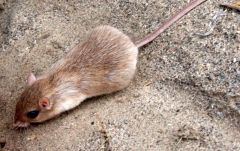
|
Chaetodipus formoscus (long-tailed pocket mouse)
*hole through rostrum; nasals extend past incisors skin: buff; soft/smooth butt fur |
|

|
Chaetodipus spinatus (spiny pocket mouse)
*hole through rostrum; nasals extend past incisors skin: buff; spiny butt fur |
|
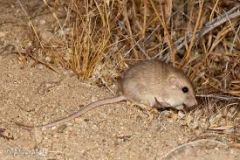
|
Perognathus longimembris (little pocket mouse)
*hole through rostrum; nasals extend past incisors skin: tiny (body size of thumb); long tail |
|

|
Perognathus parvus (Great Basin pocket mouse)
*hole through rostrum; nasals extend past incisors skin: dark color |
|
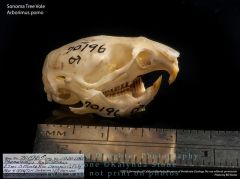
|
Arborimus pomo (Sonoma red tree vole)
*’Christmas tree’-shaped teeth skin: red skull: very curved upper incisors |
|

|
Arborimus pomo (Sonoma red tree vole)
*’Christmas tree’-shaped teeth skin: red skull: very curved upper incisors |
|
|
*Skull: Christmas tree teeth, pointed short palate
|
Myodes californicus (California red-black vole)
*’Christmas tree’-shaped teeth skin: slightly red on black coloring skull: short palate with pointed tip |
|

|
Myodes californicus (California red-black vole)
*’Christmas tree’-shaped teeth skin: slightly red on black coloring skull: short palate with pointed tip |
|

|
Lemmiscus curtatus (sagebrush vole)
*’Christmas tree’-shaped teeth skin: smallest tail extends just past feet; scruffy light brown fur skull: spongy auditory bullae |
|

|
Lemmiscus curtatus (sagebrush vole)
*’Christmas tree’-shaped teeth skin: smallest tail extends just past feet; scruffy light brown fur skull: spongy auditory bullae |
|

|
Microtus (some voles)
*’Christmas tree’-shaped teeth skull: appears to have a lot of cheekteeth |
|
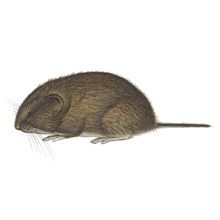
|
Microtus californicus (California meadow vole)
*’Christmas tree’-shaped teeth skin: tail is ~2x feet length (<1/3 body length); bigger |
|

|
Microtus longicaudus (long-tailed vole)
*’Christmas tree’-shaped teeth skin: tail is ~2.5x feet length (>1/3 body length); smaller |
|

|
Ondatra zibethicus (muskrat)
*’Christmas tree’-shaped teeth skin: 2 sagittal crest bumps at the middle skull: large; bare, skinny tail |
|

|
Ondatra zibethicus (muskrat)
*’Christmas tree’-shaped teeth skin: 2 sagittal crest bumps at the middle skull: large; bare, skinny tail |
|

|
Phenacomys intermedius (heather vole)
*’Christmas tree’-shaped teeth skin: scruffy head; tiny tail (x1.5 feet length); dark color skull: short palate with rounded tip |
|
|
*skull: Christmas tree teeth with short, rounded palate
|
Phenacomys intermedius (heather vole)
*’Christmas tree’-shaped teeth skin: scruffy head; tiny tail (x1.5 feet length); dark color skull: short palate with rounded tip |
|

|
Reithrodontomys megalotus (western harvest mouse)
skin: smaller (than Mus); white belly; dark back skull: super tiny/fragile; grooved incisors |
|

|
Reithrodontomys megalotus (western harvest mouse)
skin: smaller (than Mus); white belly; dark back skull: super tiny/fragile; grooved incisors |
|

|
Neotoma (woodrats)
skull: rooted teeth; weak temporal ridges; teeth between Christmas tree and S shape. |
|

|
Neotoma cinerea (bushy-tailed woodrat)
skin: gray color; bushy tail |
|

|
Neotoma fuscipes (dusky-rooted woodrat)
skin: fuzzy tail; bicolored feet; chocolate unicolor fur |
|

|
Neotoma lepida (desert woodrat)
skin: bare-ish, bicolored tail; pale gray color |
|

|
Onychomys leucogaster (northern grasshopper mouse)
skin: mouse chinchilla skull: 1st mandible bump > 2nd mandible bump (coronoid > condyloid); flip-flop shaped teeth |
|
|
*Skull: 1st>2nd mandible bump
|
Onychomys leucogaster (northern grasshopper mouse)
skin: mouse chinchilla skull: 1st mandible bump > 2nd mandible bump (coronoid > condyloid); flip-flop shaped teeth |
|

|
Peromyscus (some mice)
skull: 1st mandible bump < 2nd mandible bump (coronoid < condyloid) |
|

|
Peromyscus boylii (brush mouse)
skin: tail hair sparse enough to see annulations (tail grooves/lines) |
|

|
Peromyscus maniculates (deer mouse)
skin: speckled tail, too furred to see annulations (tail grooves/lines) |
|
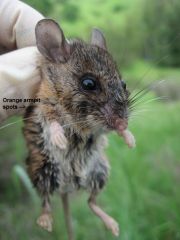
|
Peromyscus truei (pinyon mouse)
skin: orange ‘armpit’ spots prominent; tail too furred to see annulations (tail grooves/lines) |

